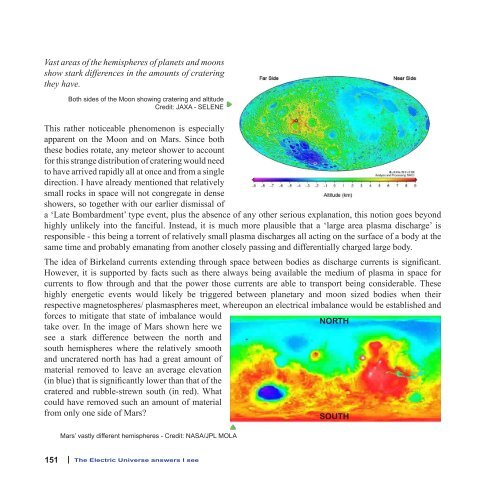A Beginner's View of Our Electric Universe - New
A Beginner's View of Our Electric Universe - New
A Beginner's View of Our Electric Universe - New
You also want an ePaper? Increase the reach of your titles
YUMPU automatically turns print PDFs into web optimized ePapers that Google loves.
Vast areas <strong>of</strong> the hemispheres <strong>of</strong> planets and moons<br />
show stark differences in the amounts <strong>of</strong> cratering<br />
they have.<br />
Both sides <strong>of</strong> the Moon showing cratering and altitude<br />
Credit: JAXA - SELENE<br />
This rather noticeable phenomenon is especially<br />
apparent on the Moon and on Mars. Since both<br />
these bodies rotate, any meteor shower to account<br />
for this strange distribution <strong>of</strong> cratering would need<br />
to have arrived rapidly all at once and from a single<br />
direction. I have already mentioned that relatively<br />
small rocks in space will not congregate in dense<br />
showers, so together with our earlier dismissal <strong>of</strong><br />
a ‘Late Bombardment’ type event, plus the absence <strong>of</strong> any other serious explanation, this notion goes beyond<br />
highly unlikely into the fanciful. Instead, it is much more plausible that a ‘large area plasma discharge’ is<br />
responsible - this being a torrent <strong>of</strong> relatively small plasma discharges all acting on the surface <strong>of</strong> a body at the<br />
same time and probably emanating from another closely passing and differentially charged large body.<br />
The idea <strong>of</strong> Birkeland currents extending through space between bodies as discharge currents is significant.<br />
However, it is supported by facts such as there always being available the medium <strong>of</strong> plasma in space for<br />
currents to flow through and that the power those currents are able to transport being considerable. These<br />
highly energetic events would likely be triggered between planetary and moon sized bodies when their<br />
respective magnetospheres/ plasmaspheres meet, whereupon an electrical imbalance would be established and<br />
forces to mitigate that state <strong>of</strong> imbalance would<br />
NORTH<br />
take over. In the image <strong>of</strong> Mars shown here we<br />
see a stark difference between the north and<br />
south hemispheres where the relatively smooth<br />
and uncratered north has had a great amount <strong>of</strong><br />
material removed to leave an average elevation<br />
(in blue) that is significantly lower than that <strong>of</strong> the<br />
cratered and rubble-strewn south (in red). What<br />
could have removed such an amount <strong>of</strong> material<br />
from only one side <strong>of</strong> Mars?<br />
SOUTH<br />
Mars’ vastly different hemispheres - Credit: NASA/JPL MOLA<br />
151 | The <strong>Electric</strong> <strong>Universe</strong> answers I see


